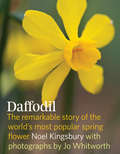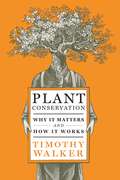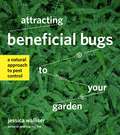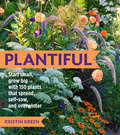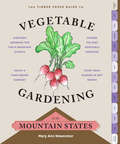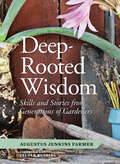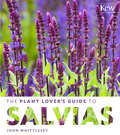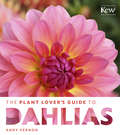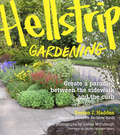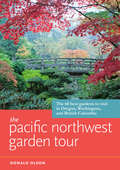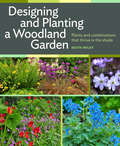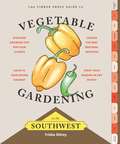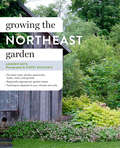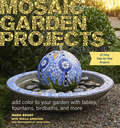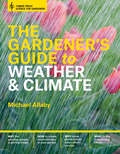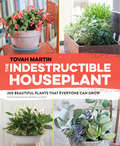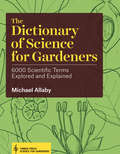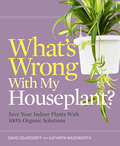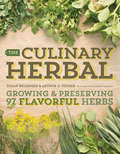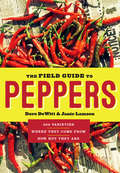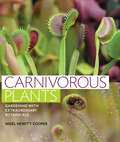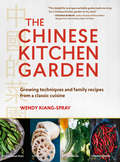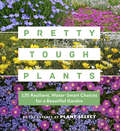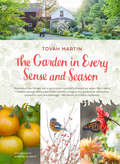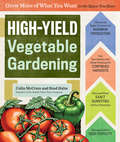- Table View
- List View
Daffodil: The remarkable story of the world's most popular spring flower
by Noel Kingsbury Jo WhitworthThere is no harbinger of spring like a field or garden filled with bright yellow daffodils. But the world of the daffodil is much more than just its place in the march of the seasons. It’s a plant whose history starts with the tombs of the Pharaohs, through pre-Darwin evolutionary theory and Cornwall’s burgeoning bulb business, and leads to the current explosion of varieties from plant breeders seeking new colors, fragrances, and forms.Daffodil reveals a global plant infatuation that has led to more than 25,000 cultivars available in nearly every shade of yellow (and now pink, orange, and white). Noel Kingsbury tells the tale through an engaging narrative history and plant portraits that highlight more than 200 varieties. Jo Whitworth's revealing photography shows a side of the daffodil rarely seen. Plant lovers will relish the stories and gardeners will cherish the cultivation notes, plant descriptions, and recommendations.
Plant Conservation: Why It Matters and How It Works
by Timothy WalkerPlants’ ability to turn sunlight into energy makes them the basis for all life; without them there is no life. And they are more than just a food source—they provide us with fuel, fibers, and pharmaceuticals. Global warming and the destruction of natural habitats are a serious threat to many plants, and there are worldwide efforts to mitigate the disaster. Plant Conservation tackles this essential topic head on. Timothy Walker, as the director of the Oxford Botanical Garden, a leader in the field of plant conservation, plays a key role in this effort. He highlights what is happening now, from cataloging the world’s flora to conservation efforts like protecting plants from overcollecting. He also shows home gardeners how they can become involved, whether by growing their own food to decrease reliance on large agriculture or by making smart plant choices by growing natives and avoiding invasives. Plant Conservation treats a critical topic in an accessible and optimistic way. It is required reading for students, professionals, and anyone with a keen interest in the importance of plants.
Attracting Beneficial Bugs to Your Garden: A Natural Approach to Pest Control
by Jessica WalliserWinner of the American Horticultural Society Book Award Insects are indeed valuable garden companions, especially the assassin bugs, damsel bugs, stink bugs, and other predatory carnivores that eat the insects that dine on your garden. Attracting Beneficial Bugs to Your Garden is a book about bugs and plants, and how to create a garden that benefits from both. In addition to information on companion planting and commercial options for purchasing bugs, there are 19 detailed bug profiles and 39 plant profiles. These profiles include a description, a photograph for identification, an explanation of what they can do to support pest control. Design plans show how to create a border specifically for the natural, sustainable inclusion of beneficial bugs in your garden.
Plantiful: Start Small, Grow Big with 150 Plants That Spread, Self-Sow, and Overwinter
by Kristin Green“Thrifty gardeners take note: the bucks saved on plant purchases will pay back the purchase price of Plantiful with dividends.” —Tovah Martin, author of The Unexpected Houseplant Whoever coined the phrase “money doesn’t grow on trees” must not have been a resourceful gardener. Plantiful shows you how to have an easy, gorgeous garden packed with plants by simply making the right choices. Kristen Green highlights plants that help a garden quickly grow by self-sowing and spreading and teaches you how to expand the garden and extend the life of a plant by overwintering. The book features plant profiles for 50 self-sowers (including columbine, milkweed, and foxglove), 50 spreaders (such as clematis, snow poppy, and spearmint), and 50 plants that overwinter (including lemon verbena, begonia, and Chinese hibiscus). Additional gardening tips, design ideas, and inspirational photos will motivate and inspire gardeners of all levels.
The Timber Press Guide to Vegetable Gardening in the Mountain States (Regional Vegetable Gardening Series)
by Mary Ann NewcomerGrowing vegetables requires regionally specific information—what to plant, when to plant it, and when to harvest are based on climate, weather, and first frost. The Timber Press Guide to Vegetable Gardening in the Mountain States tackles this need head on, with regionally specific growing information written by local gardening expert, Mary Ann Newcomer. This region includes Idaho, Montana, Wyoming, Utah, Colorado, eastern Washington and Oregon, northern Nevada, and the southernmost parts of Alberta and Saskatchewan. Monthly planting guides show exactly what you can do in the garden from January through December. The skill sets go beyond the basics with tutorials on seed saving, worm bins, and more.
Deep-Rooted Wisdom: Skills and Stories from Generations of Gardeners
by Augustus Jenkins FarmerWe have begun to lose some of the most important skills used by everyday gardeners to create beautiful, productive gardens. With a personality-driven, engaging narrative, Deep Rooted Wisdom teaches accessible, commonsense skills to a new generation of gardeners. Soulful gardener, Augustus Jenkins Farmer, profiles experienced and up-and-coming gardeners who use these skills in their own gardens. Enjoy this chance to get planting, propagation, and fertilizing knowledge handed down directly from the experts in the field.
The Plant Lover's Guide to Salvias (The Plant Lover’s Guides)
by John WhittleseySalvias are available in a huge range of sizes, colors, foliage, and hardiness, with over 900 species and hundreds of hybrids. Salvia’s popularity stems from how easy they are to grow, their multiple medicinal and culinary uses, and the vibrancy of their blooms that cover every color in the spectrum from white to nearly black. The Plant Lover’s Guide to Salvias features everything you need to know to grow this vibrant and fragrant plant. Plant profiles of 150 varieties highlight each plant’s type, habitat, size, hardiness, origin, cultivation, and use in the landscape. Additional information includes tips on design, how to grow and propagate salvia, where to view them in public gardens, and where to buy them.
The Plant Lover's Guide to Dahlias (The Plant Lover’s Guides)
by Andy VernonDahlias are the showgirls of the garden. A favorite of floral and landscape designers, they come in a wide range of jewel-like colors—rich reds and vibrant oranges, shocking pinks—and an engaging variation of form and petal shape. The Plant Lover’s Guide to Dahlias is packed with everything you need to know to grow these fantastic flowers including tips on using dahlias in garden design, growth and propagation information, and lists of where to buy the plants and where to view them in public gardens. The bulk of the book is devoted to profiles for over 200 varieties, organized by color, with information on type, height, and spread. Gorgeous color photographs bring the plants to life.
Hellstrip Gardening: Create a Paradise between the Sidewalk and the Curb
by Evelyn Hadden Joshua McCulloughThe hellstrip—also known as a boulevard, meridian, and planting strip—is finally getting the attention it deserves! Gardeners everywhere are taking advantage of the space to add curb appeal to their homes, expand the size of their gardens, and conserve more resources. Hellstrip Gardening is the first book to show you exactly how to reclaim these oft-ignored spaces by determining the city and home owner's association rules, choosing plants that thrive in tough situations, designing pathways for accessibility, and much more. Gorgeous color photographs of hellstrip gardens across the country offer inspiration and visual guidance to anyone ready to tackle this final frontier.
The Pacific Northwest Garden Tour: The 60 Best Gardens to Visit in Oregon, Washington, and British Columbia
by Donald Olson“Your must-visit list of Northwest gardens is finally organized and illustrated.” —Sunset Oregon, Washington, and British Columbia have a wealth of top-notch public gardens. In The Pacific Northwest Garden Tour veteran travel writer Donald Olson highlights sixty of the most outstanding options and provides all the information you need to make the most of your visit. This gorgeous and useful guide includes cherished public gardens and a handful of the most groundbreaking nurseries. Packed with memorable stories and stunning photography, it is a fantastic garden tour that only the scenic Pacific Northwest can provide.
Designing and Planting a Woodland Garden: Plants and Combinations that Thrive in the Shade
by Keith WileyFrom the creator of "one of the most exciting and innovative gardens in Britain today" With their moss-covered stones, towering trees, and pockets of quiet shade, woodlands have a romantic power unlike anything else. Whether your garden is currently open and sunny, or on the small side, you can capture that sylvan atmosphere with carefully chosen trees and shade-loving plants. In Designing and Planting the Woodland Garden, Keith Wiley explains how to combine plants in natural, self-supporting colonies. His hand-picked selection of unexpected collectables—shrubs, perennials, bulbs, ferns, and grasses—mingle with garden favorites to create fabulous effects in all seasons.
Timber Press Guide to Vegetable Gardening in the Southwest (Regional Vegetable Gardening Series)
by Trisha ShireyThere is nothing more regionally specific than vegetable gardening—what to plant, when to plant it, and when to harvest are decisions based on climate, weather, and first frost. The Timber Press Guide to Vegetable Gardening in the Southwest, by regional expert Trisha Shirey, focuses on the unique eccentricities of the Southwest gardening calendar, which include extreme temperatures and low rainfall. The month-by-month format makes it perfect for beginners and accessible to everyone— gardeners can start gardening the month they pick it up. Perfect for home gardeners in Arizona, Nevada, New Mexico, Oklahoma, Texas, Utah, eastern California, and southern Colorado.
Growing the Northeast Garden: Regional Ornamental Gardening (Regional Ornamental Gardening Series)
by Andrew Keys Kerry MichaelsPlant selection and garden style are deeply influenced by where we are gardening. To successfully grow a range of beautiful ornamental plants, every gardener has to know the specifics of the region’s climate, soil, and geography. Gardeners in the northeast are lucky—the regular summer rain, gorgeous summer blooms, and stunning fall color make it an ideal place to garden. But there are drawbacks, like hot and humid summers, bitterly cold winters, and mosquitos. TThe practical and beautiful Growing the Northeast Garden starts with a comprehensive overview of the weather and geography of the area, along with regionally specific advice on zones, microclimates, soil, pests, and maintenance. Profiles of the best trees, shrubs, perennials, annuals, and bulbs offer hundreds of plant suggestions, along with complete information on growth and care.
Mosaic Garden Projects: Add Color to Your Garden with Tables, Fountains, Bird Baths, and More
by Mark Brody Sheila Ashdown“This thorough guide to techniques, tools, and materials is filled with expert tips and tricks. The detailed project instructions will inspire you to make your own mosaicked mark on the landscape.” —Lorene Edwards Forkner, author of Handmade Garden Projects In Mosaic Garden Projects, artist Mark Brody walks step-by-step through the creation of 25 decorative yet functional projects. With simple ideas like address signs and stepping stones to more complex projects such as an orb fountain, Brody also includes with a primer on the fundamentals of mosaic and information on the range of possible materials. Project templates are included along with instructions on how to scale each project. Mosaic Garden Projects is packed with inspiration that will brighten the garden all year long.
The Gardener's Guide to Weather and Climate: How to Understand the Weather and Make It Work for You (Science For Gardeners Ser.)
by Michael Allaby“We owe it to our plants to read this book. After all, while we just live with the weather, our plants have to survive it.” —The Washington Post All gardeners are at the whim of Mother Nature, and so are our plants. Whether it’s coping with extreme drought or record-breaking snow fall, gardeners—and gardens—across the country are fighting against the elements. Instead of just reacting to the weather, Michael Allaby suggests that gardeners use knowledge about how the weather works to create the best growing conditions for their plants. Allaby brings big-picture atmospheric concepts to life with a comprehensive introduction to how weather works and explanations climate change, weather systems, and microclimates. The Gardener’s Guide to Weather and Climate proves that instead of gardening at the mercy of the weather, knowledgeable gardeners can make the weather work for them
The Indestructible Houseplant: 200 Beautiful Plants that Everyone Can Grow
by Tovah MartinThe Indestructible Houseplant, by garden writer Tovah Martin, eliminates the guesswork by highlighting indoor plants that are tough, beautiful, reliable, and readily available. Like hoya, a low-maintenance plant whose spectacular spring and summer blossoms actually thrive on neglect. Or Ficus elastica (also known as rubber tree), whose pink and gray leaves will brighten even the most challenging windowless environment. And castiron plant, an old favorite that remains beautiful in a shady corner, even after weeks without water. In addition to plant profiles with concise information on water, light, and blooming times, this gorgeous book includes tips on care, maintenance, and ideas for combining houseplants in eye-catching indoor displays.
The Dictionary of Science for Gardeners: 6000 Scientific Terms Explored and Explained (Science For Gardeners Ser.)
by Michael AllabyA Library Journal Best Reference Pick of 2015! Every gardener is a scientist. Pollination, native plants, ecology, climatology—these are just a few of the scientific concepts that play a key role in a successful garden. While the ideas are intuitive to many gardeners, they are often discussed in unfamiliar scientific terms. The Dictionary of Science for Gardeners is the first of its kind to provide practical scientific descriptions for gardening terms. Highlighting 16 branches of science that are of particular interest to gardeners, with entries from abaptation to zoochory, Michael Allaby explores more than 6,000 terms in one easy-to-use reference.
What's Wrong With My Houseplant?: Save Your Indoor Plants With 100% Organic Solutions (What’s Wrong Series)
by David Deardorff Kathryn WadsworthThis book will turn even the brownest thumbs green! Houseplants add style, clean the air, and bring nature indoors. But they are often plagued with problems—aphids, mealybugs, mites, and thrips to name just a few. What’s Wrong With My Houseplant? shows you how to keep indoor plants healthy by first teaching you how to identify the problem and solve it with a safe, natural solution. This hardworking guide includes plant profiles for 148 plants organized by type with visual keys to the most of common problems, and the related organic solutions that will lead to a healthy plant.
The Culinary Herbal: Growing and Preserving 97 Flavorful Herbs
by Arthur O. Tucker Susan Belsinger Shawn Linehan“This fresh new masterpiece excites the senses!” —Rosemary Gladstar, herbalist and bestselling author Good cooks know that when it comes to herbs, there is nothing better than those that are clipped fresh from the garden. The Culinary Herbal highlights 97 delicious varieties—like black cumin, fenugreek, lemon balm, and sassafras—that every food lover will want to add to their kitchen garden. In this gorgeously photographed guide, home cooks will learn which herbs offer the most flavor, how to grow them at home, and how to put them to use. Plant profiles are organized alphabetically by herb type and include basic growing information, flavor notes, and culinary uses. Additional information includes step-by-step instructions for harvesting, preserving, and storing, along with techniques for making pastes, syrups, vinegars, and butters.
The Field Guide to Peppers: 400 Varieties - Where They Come From - How Hot They Are
by Dave DeWitt Janie LamsonThe essential guide for pepper enthusiasts! A little spice can really take a meal to the next level—but with so many peppers to choose from, how do you pick one capsicum from another? In The Field Guide to Peppers, Dave DeWitt and Janie Lamson give expert advice on popular varieties like ancho, cayenne, jalapeño, serrano, and more. The 400 profiles in this fiery guide include all the major types of peppers, and each page features a color photograph along with all the details a pepperhead needs to know: common name, origin, source, pod length and width, plant height, color, harvest, and heat level, ranging from sweet to superhot.
Carnivorous Plants: Gardening with Extraordinary Botanicals
by Nigel Hewitt-CooperOnce known only to collectors, adolescent boys, and fans of the cult film The Little Shop of Horrors, carnivorous plants are poised to be the next big trend in home gardening. They provide striking architectural style and can be grown indoors and outdoors. Carnivorous Plants is an accessible, smartly designed guide to growing this unusual group of plants. It offers a general introduction to the world of carnivorous plants, and growing and cultivation information for commonly available and easily grown varieties. Nigel Hewitt-Cooper also provides advice on where to grow the plants; year-round care, cultivation, and maintenance; and a directory of the best carnivorous plants for home gardeners.
The Chinese Kitchen Garden: Growing Techniques and Family Recipes from a Classic Cuisine
by Wendy Kiang-SprayWinner of the Garden Writers Association 2018 Silver Medal of Achievement Wendy Kiang-Spray’s family has strong culinary and gardening traditions. In The Chinese Kitchen Garden, she beautifully blends the story of her family’s cultural heritage with growing information for 38 Chinese vegetables—like lotus root, garlic, chives, and eggplant—and 25 traditional recipes like congee, dumplings, and bok choy stir-fry. Organized by season, you’ll learn what to grow in spring and what to cook in winter.
Pretty Tough Plants: 135 Resilient, Water-Smart Choices for a Beautiful Garden
by Plant SelectTough-but-beautiful plant picks There’s a growing demand for dependably hardy plants that require less maintenance and less water, but look no less beautiful in the garden. Plant Select—the leading purveyor of plants designed to thrive in difficult climates—meets this need by promoting plants that allow gardeners everywhere to have stunning, environmentally-friendly gardens that use fewer resources. Pretty Tough Plants highlights 135 of Plant Select’s top plant picks. Each profile features a color photograph and specific details about the plant’s size, best features, and bloom season, along with cultural needs, landscape features, and design ideas. The plant list includes perennials and annuals, groundcovers, grasses, shrubs, and trees. A chart at the end of the book makes it easy to choose the right plants for specific conditions and needs.
The Garden in Every Sense and Season: Gardening to Awaken Your Five Senses
by Tovah Martin Kindra Clineff“Reminds us that the best way to get to know a garden is through our senses.” —Gardenista So much of gardening is focused on the long list of chores—the weeding, planting, and pruning. But what about the joy a garden can provide? In The Garden in Every Sense and Season, Tovah Martin explores the sensory delights in her own garden in 100 evocative essays. Martin shares sage garden advice, offers intimate reflections on her own garden, and urges us to inhale, savor, and become more attuned to our gardens. Packed with lush color photographs, The Garden in Every Sense and Season will help you grow a bounty of gratitude in your own home garden.
High-Yield Vegetable Gardening: Grow More of What You Want in the Space You Have
by Colin McCrate Brad HalmYou won’t believe your eyes when you see the size of your harvest! In High-Yield Vegetable Gardening, authors Colin McCrate and Brad Halm show how you can make your food garden much more productive, no matter how big or small it is. You’ll learn their secrets for preparing the soil, selecting and rotating your crops, and mapping out a specific customized plan to make the most of your space and your growing season. Packed with the charts, tables, schedules, and worksheets you need — as well as record-keeping pages so you can repeat your successes next year — this book is an essential tool for the serious gardener.
